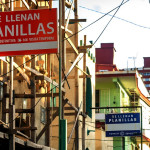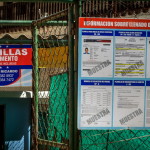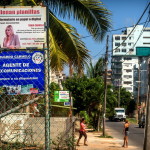
Embassy zone
HAVANA — “We fill forms, safeguard handbags and cell phones!” calls out a woman standing at the head of the line, which is not a line but a continuum of people who fan themselves, sweat, talk on the phone, hold their foreheads, glance at their watches, talk incessantly, meditate and think again.
No wonder they call it “the Park of Sighs.” Maybe it’s bad taste that the U.S. Embassy is so close to a funeral home. “Creepy,” someone might say, if this were a movie.
About 200 yards away, behind a diner counter, Zenaida (not her real name) laments how tranquil the environment is. “Not too long ago,” the employees of the former SINA — the U.S. Interests Section — had their lunch hour trimmed and now they have no time to come over for a cup of coffee.
“I used to wait for them,” Zenaida says. “When the clock struck 12, I would say, ‘the gang is about to arrive.'”
A group of maintenance workers paint the masts of the Mount of Flags. Others paint the side buildings, along Calzada Street. Even while it was the U.S. Interests Section, many called it “the American embassy.”
“Life remains the same,” says Gonzalo, a parking attendant, who says that the consular office has handled fewer visa applications in recent days, because a container with new electronic equipment arrived “and inside everything is being computerized.”
“They’re waiting for that gentleman to come on the 14th,” he says, alluding to Secretary of State John Kerry.
Tourism vehicles, private cars and state-owned cars use the parking lot, where service is 1 convertible peso more expensive than in other parking places. “At the corner restaurant, they charge 3 pesos for valet parking. They take your car, park it somewhere and then return it to you,” says Ramón, interrupting his work when, as usual, the boy who sells tamales arrives on his bicycle.
The neighborhood shows its many faces. The residential Vedado, the decadent Vedado, the poor Vedado, the Vedado under construction.
Everywhere, you find houses where the residents fill visa applications for 20 pesos each. “Serious and guaranteed,” says a sign, next to another that says “Instant photos; no charge.”
Inside, the “paperwork offices” are equipped with everything that’s necessary: scanner, printer, photocopier, a still camera. There may be too much competition but so much offer and demand means only one thing: lots of demand.
When did they get the idea for this line of business, I ask. How many people come here each day? Have things changed since Dec. 17? Will things be different now that this is an embassy? Despite the helpful signs, nobody answers.
“No, I’m not interested,” a young woman tells me from behind a computer. On the wall, a diploma identifies her as a Graduate in Social Communication.
In a two- or three-block radius, coffee shops proliferate like mushrooms. “I’ve got food!” shouts a woman wearing a headband and a lycra outfit with the Stars and Stripes. At a glance, she seems to be wearing a uniform.
Around me I see telecommunications agents, rooms for rent in convertible pesos or Cuban pesos, street vendors. “Taxi, taxi!” I hear people shouting. Safekeeping your handbag will cost you 1 convertible peso until 5 p.m. “or whenever,” Dinora tells me.
People wait in bunches, they make themselves as comfortable as possible; any container serves as a seat, any tree or door serves as protection from the sun. There are many ways to wait. Some people come from far away, very far away.
“We showered and rested a while. Now we’re going to Coppelia. Wait, I’ll put your mother on,” a man over 60 speaks into his cell phone. A child gets restless — maybe because of the heat, maybe because he’s sitting in a wheeled baby carrier — and cries. The line doesn’t seem to move. “Listen, it’s Dayana, Luis’ sister. No, we’re still waiting.”
According to official sources, about 1.4 million Cubans (12.5 percent of the nation’s population) live outside the island, 85.7 percent of whom live in the United States. In 2012, 47,384 Cubans left for that country; 80,522 in 2013, for the purpose of family reunification or for non-emigration tours. All of them came through here.
Progreso Weekly authorizes the total or partial reproduction of the articles written by our journalists, so long as source and author are identified.






